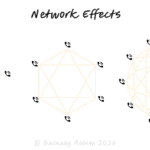Network Effects
Economics of networks (Katz & Shapiro; Metcalfe; Rochet & Tirole; modern platform strategy)

Network effects arise when each new participant increases value for others. They can be same-side (messaging app) or cross-side (buyers ↔ sellers). Strong network effects create defensibility and can drive winner-take-most outcomes—until congestion, spam or multi-homing erode them. The goal is to reach critical liquidity in a focused niche, then expand while protecting interaction quality.
Types
- Direct (same-side) – more users → more people to message/play with.
- Indirect / two-sided (cross-side) – more of side A attracts side B (marketplaces, ad platforms).
- Data/learning – more usage → better models → better product (search, recommendations).
- Protocol/standard – compatibility (file formats, APIs) increases with adoption.
Strength vs size
- Value typically scales with quality-adjusted connections, not raw n. Heuristics: ~n·log n or ~n² when everyone meaningfully connects.
- Liquidity metrics beat vanity counts (e.g., time-to-first-match, % of requests fulfilled < X mins, messages/user/day).
Cold start & critical mass
- Networks need a minimum density before they feel useful. You get there by seeding an atomic network (one company, campus, city, category).
Friction & decay
- Negative network effects (congestion, spam, low quality) reduce value as size grows unless you add governance and ranking.
Marketplaces – riders ↔ drivers, buyers ↔ sellers, talent ↔ employers.
Social/communication – communities, messaging, creator–audience platforms.
Platforms & APIs – app stores, integrations, payment rails.
Data products – search, fraud detection, recommender systems.
Standards/protocols – file formats, payments, identity, interoperability.
Define the core interaction – the smallest repeatable action that creates value for both sides (e.g., buyer finds relevant seller and transacts).
Choose your atomic network – single niche where you can reach liquidity fast (one geo, vertical, cohort).
Set liquidity metrics – pick 2–3 leading indicators: % matched < X mins, edges per user in week 1, messages that get a reply, repeat usage by day 7/28.
Solve the chicken-and-egg
Subsidise the hard side (cash, tools, demand guarantees).
Single-player utility (useful even alone: creation tools, analytics, drafting).
Bootstrap supply (manually curate, scrape/seed inventory, partnerships).
Raise interaction quality – ranking, reputation, reviews, verification, spam/fraud controls; design minimum quality bars.
Reduce multi-homing – switching costs (data/portfolio portability with differentiators), workflow integration, loyalty, unique demand.
Expand adjacently – after one atomic network is liquid, add nearby categories/geos; reuse playbooks and shared trust systems.
Instrument feedback loops – track k-factor, cohort retention vs local density, cross-side elasticity (how much more side B joins when A grows).
Governance & incentives – fees, rewards, and rules that align participants with network health; punish free-riding and abuse.
Confusing virality with network effects – shares can create growth without increasing in-product value; measure on-network utility.
Counting users, not liquidity – a big but thin network feels empty; optimise density and response times.
Ignoring negative effects – spam, scams, overcrowding; add rate limits, deposits, identity and ranking.
Over-broad launch – spreading thin across geos/categories prevents any node reaching critical mass.
Subsidising the wrong side – give value where constraint actually is (usually supply at the start).
Complacent defensibility – assume lock-in; multi-homing and interoperability can unwind moats.
